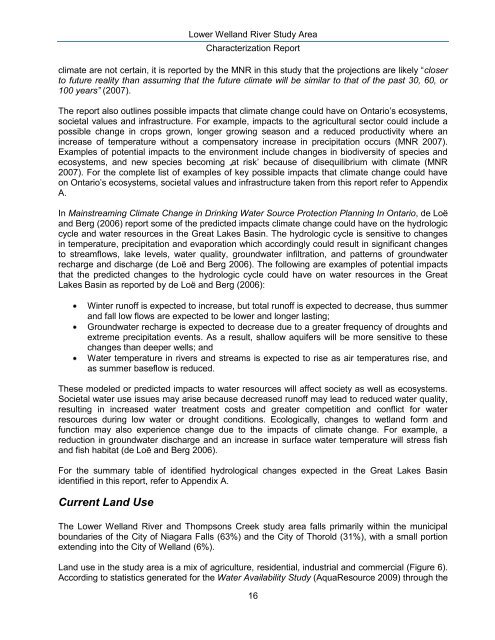Lower Welland River Characterization Report - Niagara Peninsula ...
Lower Welland River Characterization Report - Niagara Peninsula ...
Lower Welland River Characterization Report - Niagara Peninsula ...
You also want an ePaper? Increase the reach of your titles
YUMPU automatically turns print PDFs into web optimized ePapers that Google loves.
<strong>Lower</strong> <strong>Welland</strong> <strong>River</strong> Study Area<br />
<strong>Characterization</strong> <strong>Report</strong><br />
climate are not certain, it is reported by the MNR in this study that the projections are likely “closer<br />
to future reality than assuming that the future climate will be similar to that of the past 30, 60, or<br />
100 years” (2007).<br />
The report also outlines possible impacts that climate change could have on Ontario‟s ecosystems,<br />
societal values and infrastructure. For example, impacts to the agricultural sector could include a<br />
possible change in crops grown, longer growing season and a reduced productivity where an<br />
increase of temperature without a compensatory increase in precipitation occurs (MNR 2007).<br />
Examples of potential impacts to the environment include changes in biodiversity of species and<br />
ecosystems, and new species becoming „at risk‟ because of disequilibrium with climate (MNR<br />
2007). For the complete list of examples of key possible impacts that climate change could have<br />
on Ontario‟s ecosystems, societal values and infrastructure taken from this report refer to Appendix<br />
A.<br />
In Mainstreaming Climate Change in Drinking Water Source Protection Planning In Ontario, de Loë<br />
and Berg (2006) report some of the predicted impacts climate change could have on the hydrologic<br />
cycle and water resources in the Great Lakes Basin. The hydrologic cycle is sensitive to changes<br />
in temperature, precipitation and evaporation which accordingly could result in significant changes<br />
to streamflows, lake levels, water quality, groundwater infiltration, and patterns of groundwater<br />
recharge and discharge (de Loë and Berg 2006). The following are examples of potential impacts<br />
that the predicted changes to the hydrologic cycle could have on water resources in the Great<br />
Lakes Basin as reported by de Loë and Berg (2006):<br />
Winter runoff is expected to increase, but total runoff is expected to decrease, thus summer<br />
and fall low flows are expected to be lower and longer lasting;<br />
Groundwater recharge is expected to decrease due to a greater frequency of droughts and<br />
extreme precipitation events. As a result, shallow aquifers will be more sensitive to these<br />
changes than deeper wells; and<br />
Water temperature in rivers and streams is expected to rise as air temperatures rise, and<br />
as summer baseflow is reduced.<br />
These modeled or predicted impacts to water resources will affect society as well as ecosystems.<br />
Societal water use issues may arise because decreased runoff may lead to reduced water quality,<br />
resulting in increased water treatment costs and greater competition and conflict for water<br />
resources during low water or drought conditions. Ecologically, changes to wetland form and<br />
function may also experience change due to the impacts of climate change. For example, a<br />
reduction in groundwater discharge and an increase in surface water temperature will stress fish<br />
and fish habitat (de Loë and Berg 2006).<br />
For the summary table of identified hydrological changes expected in the Great Lakes Basin<br />
identified in this report, refer to Appendix A.<br />
Current Land Use<br />
The <strong>Lower</strong> <strong>Welland</strong> <strong>River</strong> and Thompsons Creek study area falls primarily within the municipal<br />
boundaries of the City of <strong>Niagara</strong> Falls (63%) and the City of Thorold (31%), with a small portion<br />
extending into the City of <strong>Welland</strong> (6%).<br />
Land use in the study area is a mix of agriculture, residential, industrial and commercial (Figure 6).<br />
According to statistics generated for the Water Availability Study (AquaResource 2009) through the<br />
16

















